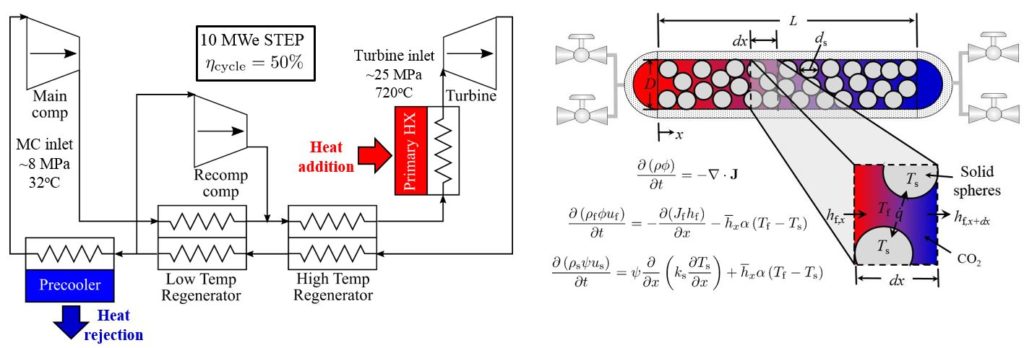Renewables and Grid-Energy Storage Systems
Modeling and Simulation of Regenerators for Supercritical CO2 Cycles
The supercritical carbon dioxide (sCO2) Brayton recompression cycle promises high cycle efficiency and potential cost savings compared to conventional steam Rankine and other power cycles. However, this cycle requires large, highly-effective, and expensive recuperators to achieve high efficiency. Regenerators may be a low-cost alternative to recuperators. A regenerator is a periodic heat exchanger in which the transfer of heat from the hot to cold fluid is temporally decoupled via a thermal energy storage media, such as a packed bed of spheres. The energy storage media is “charged” by the hot fluid during one process, then “discharged” to the cold fluid in a second process. Employing multiple regenerator beds and valves to control fluid allocation enables quasi-continuous operation. Because regenerators are simple to manufacture and consist of common materials, they may achieve waste heat recover goals at a lower cost than printed circuit recuperators.
However, regenerator operation within power cycles has not been widely characterized. In this project the AESG is partnering with researchers at University of Wisconsin-Madison (lead), the National Renewable Energy Laboratory, Sandia National Laboratory, Flowserve, and Comprex to evaluate the thermodynamic and economic performance of regenerators for sCO2 Brayton recompression cycles. While University of Wisconsin-Madison is pursuing an experimental route to validating a reduced-order regenerator model, AESG is employing transient simulation to perform a detailed investigation of regenerator operation at conditions expected within a sCO 2 recompression Brayton cycle. This allows us to capture phenomena such as entrained fluid heat capacity and local property variation, and to simulate valves opening and closing as the regenerator switches between processes. This detailed model compares well with experimental results, and is being used to inform system-level design, implementation, and operation.
FUNDING: U.S. Department of Energy APOLLO Program

Publications
- E.P. Reznicek, J.F. Hinze, L.M. Rapp, G.F. Nellis, M.H. Anderson, R.J. Braun, “One-dimensional, transient modeling of a fixed-bed regenerator as a replacement for recuperators in supercritical CO2 power cycles,” Energy Conversion and Management, 218:112921 (2020).
- E. Reznicek and R.J. Braun, “Simulation of sCO2 Recompression Brayton Cycles with Regenerators,” Proceedings of the 6th International Supercritical CO2 Power Cycles Symposium (2018).
- E. Reznicek, R.J. Braun, “Simulation of Supercritical Carbon Dioxide Brayton Recompression Cycles with Regenerative Heat Exchangers,” Proceedings of the ASME 2017 11th International Conference on Energy Sustainability, 3946 (2017).
- E. Reznicek, R.J. Braun, “Modeling and Simulation of Regenerative Heat Exchangers for Supercritical CO2 Cycles,” Proceedings of the ASME 2016 10th International Conference on Energy Sustainability, 59869 (2016).
Current Projects
Past Projects
Selected Publications in This Research Area
E.P. Reznicek, J.F. Hinze, G.F. Nellis, M.H. Anderson, R.J. Braun
Energy Conversion and Management, 229:1113678, (2021)
E.P. Reznicek, J.F. Hinze, L.M. Rapp, G.F. Nellis, M.H. Anderson, R.J. Braun
Energy Conversion and Management, 218:112921 (2020)
Simulation of sCO2 Recompression Brayton Cycles with Regenerators
E. Reznicek, R.J. Braun
Proceedings of the 6th International Supercritical CO2 Power Cycles Symposium (2018)
Simulation of Supercritical Carbon Dioxide Brayton Recompression Cycles with Regenerative Heat Exchangers
E. Reznicek, R.J. Braun
Proceedings of the ASME 2017 11th International Conference on Energy Sustainability, 3946 (2017)
Optimized Dispatch in a First-Principles Concentrating Solar Power Production Model
M.J. Wagner, A.M. Newman, W.T. Hamilton, R.J. Braun
Applied Energy, 203:959–971, (2017)
Modeling and Simulation of Regenerative Heat Exchangers for Supercritical CO2 Cycles
E. Reznicek and R.J. Braun
Proceedings of the ASME 2016 10th International Conference on Energy Sustainability, 59869 (2016)
C. Wendel, P. Kazempoor, R.J. Braun
Journal of Power Sources, 301:93–104, (2016)
S.H. Jensen, C. Graves, M. Mogensen, C. Wendel, R.J. Braun, G. Hughes, Z. Gao, S.A. Barnett
Energy and Environmental Science, 8:2471–2479, (2015)
C. Wendel, P. Kazempoor, R.J. Braun
Journal of Power Sources, 276:133–144, (2015)
C. Wendel, R.J. Braun
Journal of Power Sources, 283:329–342, (2015)
Thermodynamic Analysis of Non-Stoichiometric Perovskites as a Heat Transfer Fluid for Thermochemical Energy Storage in Concentrated Solar Power
K.J. Albrecht, R.J. Braun
Proceedings of the ASME 2015 9th International Conference on Energy Sustainability, 49409 (2015)
Model Validation and Performance Analysis of Regenerative Solid Oxide Cells: Electrolytic Operation
P. Kazempoor, R.J. Braun
International Journal of Hydrogen Energy, 39:2669–2684, (2014)
P. Kazempoor, R.J. Braun
International Journal of Hydrogen Energy, 39:5955–5971, (2014)
View Other Research Areas:
HIGH-TEMPERATURE FUEL CELLS FOR MOBILE AND STATIONARY APPLICATIONS
MODELING AND SYSTEMS ANALYSIS OF ALTERNATIVE FUEL PRODUCTION AND UTILIZATION SYSTEMS